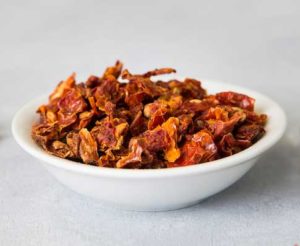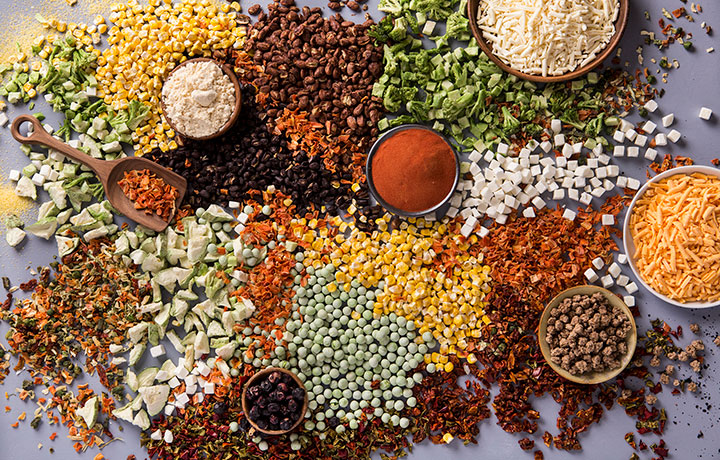Whether you’re planning to start home-drying your own foods, or are interested in blending our pre-packaged ingredients to create your own meals, understanding the difference between freeze-dried and dehydrated foods is the first step! From texture and appearance to cook-time and rehydration ratios, these key differences can make or break your DIY cooking adventure!
Let’s start by taking a close look at freeze-dried vs dehydrated tomatoes! The below chart offers a glance at some of the key similarities and differences between these two methods of preservation for one of our favorite ingredients:
FREEZE-DRIED TOMATOES
|
DEHYDRATED TOMATOES
|
|||
 |
 |
|||
FREEZE-DRIED |
DEHYDRATED |
|
| Shelf-Life | more susceptible to outside elements; shelf-life up to 25 years* | less susceptible to outside elements; shelf-life up to 15 years* |
| Weight | lighter in weight; more fragile & bulkier |
denser & heavier in weight; hardy & pack friendly |
| Taste | fresh & bright flavor | more concentrated flavor |
| Texture | crispy & edible when dry; retains shape when rehydrated | hard & inedible when dry; remains shriveled and somewhat leathery when rehydrated |
| Nutritional Content |
nutritive values retained; loss is minuscule |
some nutritive value loss occurs depending on the heat-based process or pre-cooking |
| Rehydration Time | ~ 0 – 20 minutes in hot or cold water; can be eaten without rehydration |
3 minutes -1-1/2 hours in cold water; 5-20 minutes in boiling water |
| Water Usage | less water required to rehydrate | more water required to rehydrate |
*shelf-life of both freeze-dried and dehydrated foods are dependent on both process and storage; and exposure to light, oxygen and humidity in its lifetime.
FREEZE-DRIED FOODS
WHAT IS FREEZE-DRIED FOOD?
Freeze-dried food is food that has actually been frozen then dried — surprise! The process involves freezing fresh or cooked food in a special “freeze drying chamber,” then removing the water by quickly changing the chamber’s pressure and temperature. This causes the water in the food to change from a solid to a gas without ever changing back into a liquid. In nature this is called “sublimation.” This “quick change” process perfectly preserves the cell structure (the shape and form) of the food, so a tomato actually looks like a tomato. And as a bonus, the freeze-dried tomato not only retains its form, the vitamins, nutrients, color and aroma of the tomato stays intact too — pretty incredible if you ask us!
Due to the need of specialized equipment, freeze-dried food was previously produced exclusively by large-scale manufacturers, but in the past few years personal use freeze-dryers have hit the market. In fact, you can purchase a home-freeze-dryer that’s just a little larger than your microwave!
On the Packit Gourmet website, you’ll find a great selection of freeze-dried ingredients including vegetables, meat, dairy and fruit!

WHAT ARE THE TRAITS OF FREEZE-DRIED FOODS?
Lightweight & Shelf-Stable
Freeze-dried foods are preserved by having about 98% of their water removed, making it safe to store them at room temperature for long periods of time. While proper preparation and storage play an important role in exactly how long these foods can be stored, some can stay “fresh tasting” for up to 25 years.
The lack of water content results in a product that weighs 70-90% less than when fresh, making it the perfect hiking buddy!
Appearance
Not to be partial, but in all honesty, freeze-dried foods are simply more beautiful than dehydrated! Due to the unique drying process, freeze-dried fruits, vegetables and meats look exactly the same when they enter the drying chamber as they do when they come out — retaining their color and shape. A freeze-dried chopped green pepper looks exactly like the fresh peppers you’ve prepped on your kitchen cutting board!
Taste & Texture
One of the best things about freeze-dried foods is that when they’re in their dry state, they’re as crunchy as a potato chip — and depending on the item — as delicious and addicting as one too!
Whether it’s cheddar cheese, broccoli or strawberries, these crunchy bites are perfect as a trailside snack and a fantastic healthy treat for kiddos!
And although they boast a great flavor when dry, rehydrating FD ingredients enhances the flavor back to its original fresh state. Because of the very low levels of heat that are used in the drying process, FD food is able to retain the taste, texture and aroma of its original state once its rehydrated. It’s because of this that most people find the flavor and texture of FD foods superior to that of dehydrated.
Nutrients
One key advantage of freeze-drying is that the food is preserved at the peak of ripeness and nutritional content. And while the drying process causes the food to lose its water, researchers agree that the freeze-drying process results in fewer nutrient losses than using a dehydrator. This limited loss of nutrients is most likely due to the lower temperatures in the drying process.
Rehydration
Freeze-dried foods are extremely moisture sensitive and can easily lose their vibrancy when exposed to humid air for even a short time. The benefit to this sensitivity is that their sponge-like sensibility allows them to rehydrate quickly with a minimal amount of water.
Compared to dehydrated, FD foods offer the following benefits:
- Faster rehydration with either hot or cold water — from instantly to mere minutes.
- The ability to fully rehydrate using cold water in only 15 minutes or less, while some dehydrated foods can take up to 90 minutes.
- Less water is needed to reconstitute the ingredients = less water to carry
DEHYDRATED FOODS
WHAT IS DEHYDRATED FOOD?
Dehydrated or dried food is made by slowly removing the water from the food through the use of heat. This is a practice that has been performed for hundreds of years as a means of preserving food and while most people use a home dehydrator for this process, even the natural sun can act as a dehydrator!

Depending on the water content in your food, dehydrating can be a lengthy process. After many years of dehydrating ingredients in preparation for family canoe and camping trips, it was the time-consuming nature of this process that led to the start of Packit Gourmet. Debbie (Packit Gourmet Co-Owner & Chef) found herself wishing there were pre-dried ingredients available for purchase in small quantities for DIY camp chefs. This was the first step in creating our “one-stop-shop” where trail meals & both freeze-dried and dehydrated components can all be purchased!

WHAT ARE THE TRAITS OF DEHYDRATED FOODS?
Lightweight & Shelf-Stable
Dehydration removes about 90-95% of the moisture content, making dehydrated products safe to store at room temperature for long periods of time. The equipment used (commercial vs home dehydrator), proper preparation and storage play an important role in exactly how long these foods can be stored, resulting in a range between 1-15 years.
Dehydrated products typically weigh considerably less than their fresh counterpart — for example, 1 ounce of dehydrated tomatoes is equal to 4 ounces of fresh. Nonetheless, dehydrated food is a heavier alternative to freeze-dried – for example ½ lb of fresh tomatoes will dehydrate to 2 ounces but freeze-dry to 0.5 ounce.
Appearance
When fruits and vegetables are dehydrated, the plant cells compact resulting in a shriveled appearance and brittle texture. While this does lessen with rehydration, the food will never regain its “fresh look” and will always resemble its dehydrated state.
The food also becomes considerably smaller in size. The hard and shrunken attributes of dehydrated foods are actually an advantage when backpacking since there’s no concern over crushing the food and small quantities can go on a long way in recipes!
Taste & Texture
Although dehydrated foods are inedible when dry, they plump up and soften once rehydrated. The texture of dehydrated ingredients in recipes can add flavor, body and texture that is sometimes lacking with freeze-dried ingredients.
While freeze-dried food offers a fresh and bright flavor, the process of using low heat for an extended period of time can create an intensified, almost roasted, type of flavor in dehydrated foods. For example, a dehydrated tomato’s flavor is most similar to a sundried tomato.
Nutrients
The preservation of vitamins and nutrients in dehydrated food can vary depending on the method and level of heat used in the process. And while dehydration doesn’t change the fiber or iron content of food, it can break down vitamins and minerals during the drying process and retain less of their nutritional value when compared to freeze-dried food.
Rehydration & Water Usage
The rehydration of dehydrated ingredients typically requires more time and water than its freeze-dried counterpart. For example, half of a tablespoon of water can rehydrate a ¼ cup of freeze-dried tomatoes, but only one tablespoon of dehydrated tomatoes. At the same time, the rehydration will take place instantly with freeze-dried, but requires 5 minutes in hot water or 10 minutes in cold for dehydrated.
For additional questions about freeze-dried and dehydrated foods or the Packit Gourmet products listed, please feel free to comment below or reach out to us at trailfood@packitgourmet.com!

